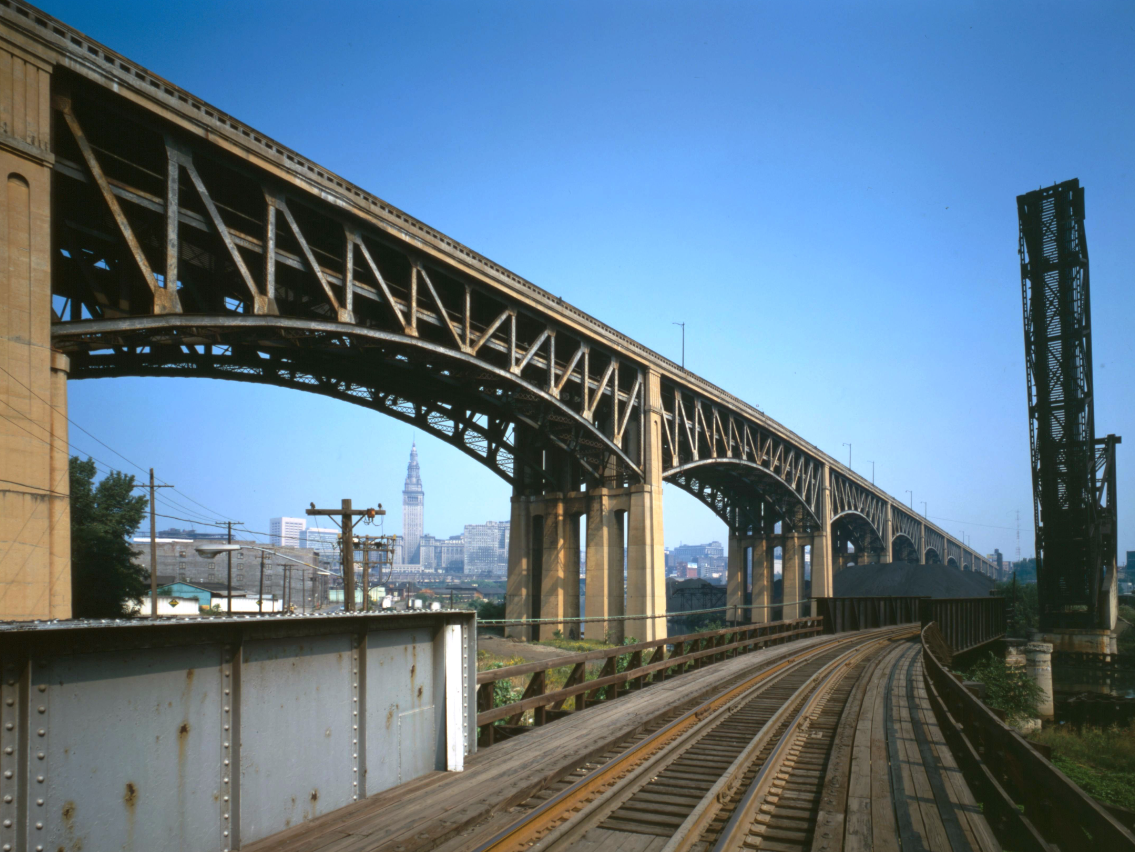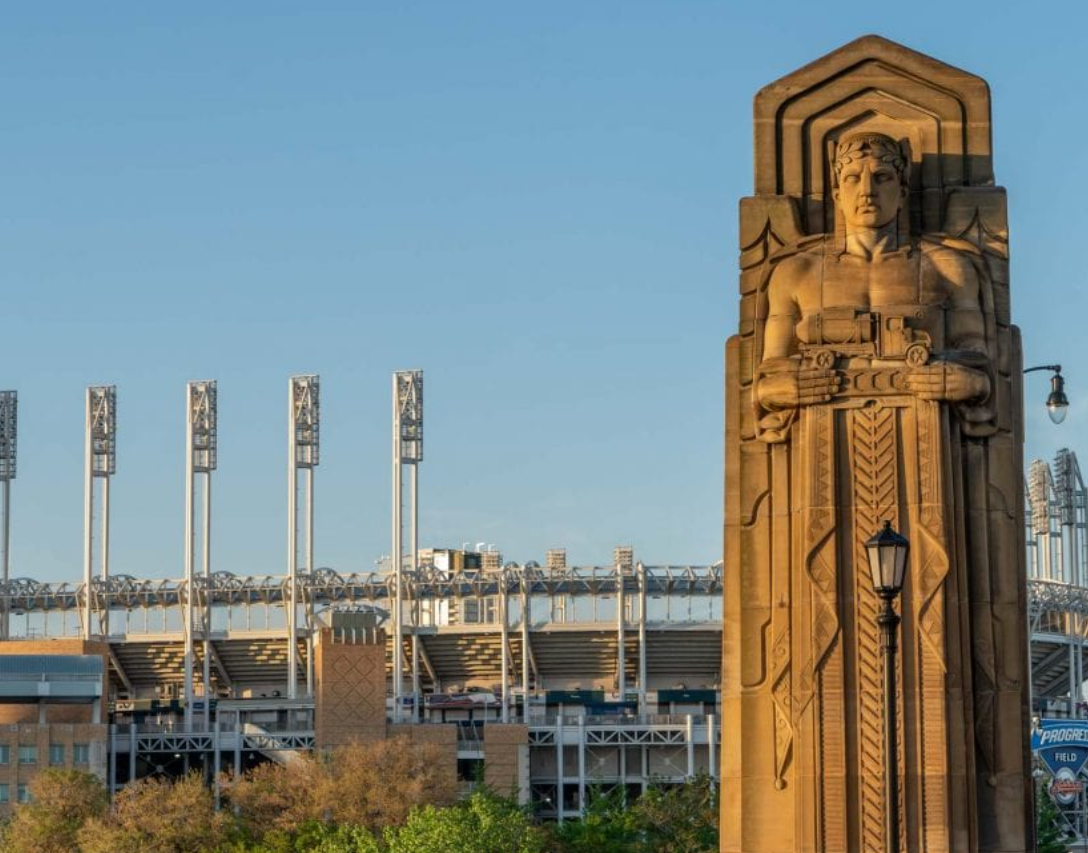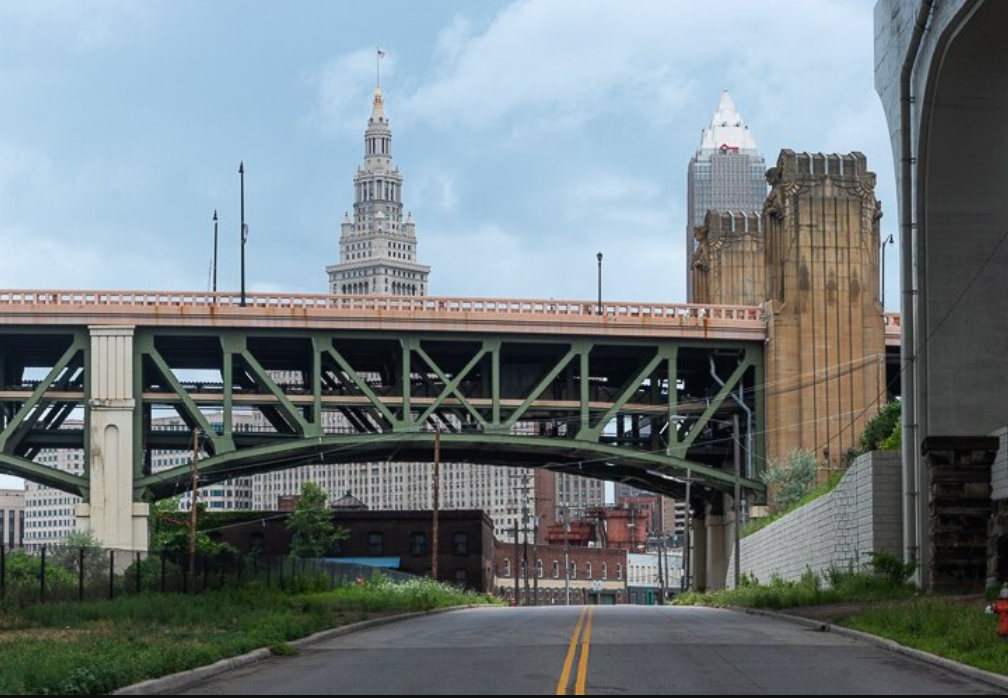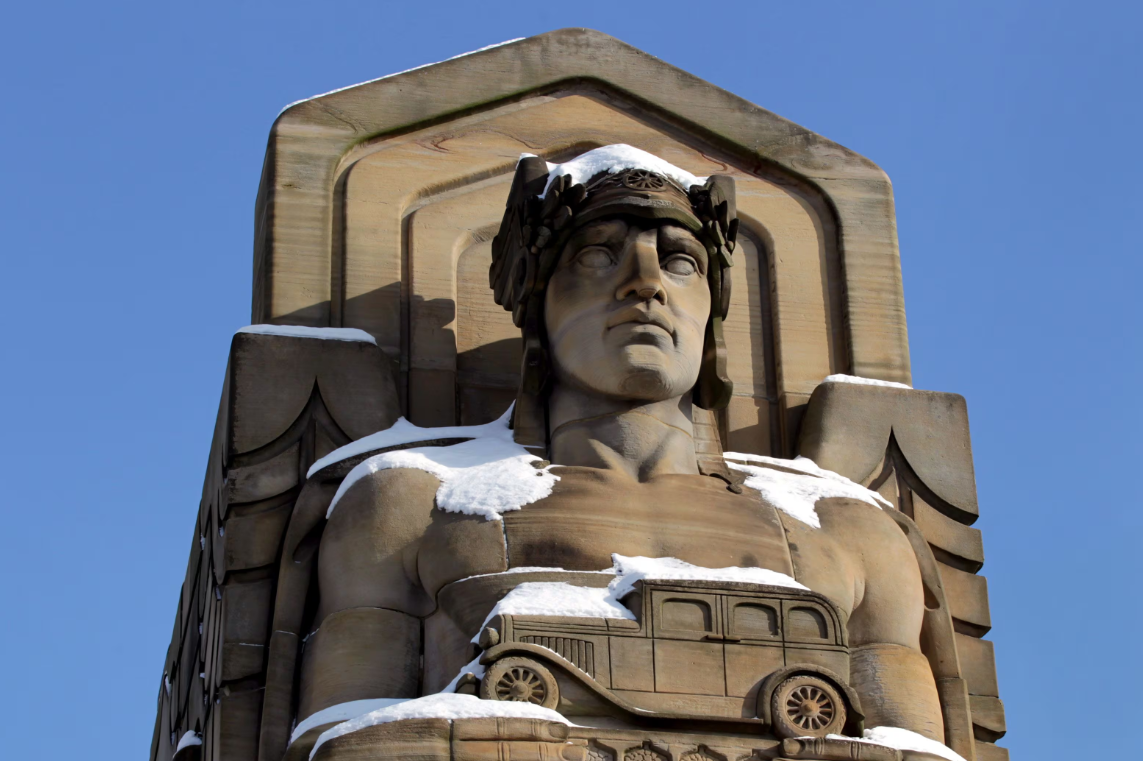The rebranding of the Cleveland Indians as the Guardians not only highlights a profound sensitivity to cultural changes but also draws an artistic and emblemical parallel with the city’s iconic Hope Memorial Bridge. This iconic structure, also known as the Lorain-Carnegie Bridge, features four colossal statues known as the “Guardians of Traffic,” which have stood watch over the city since 1932. The figures embody strength, resilience, and enduring protection, characteristics that are also central to the spirit of the Cleveland baseball team. The decision to adopt the name ‘Guardians’ aligns the team’s identity with these symbolic figures and the broader spirit of Cleveland, creating a powerful cultural resonance that underscores the city’s sense of unity and shared history.
The Hope Memorial Bridge, designed by architectural firm Walker and Weeks, is an emblem of Cleveland. Its stone sentinels, each holding a different vehicle to represent the history of ground transportation, symbolize the city’s industrial roots and its ongoing evolution. The Cleveland Guardians, by drawing their name from these figures, are not only acknowledging the city’s deep connection with its past but also hinting at a future that embraces change while honoring tradition.
The team’s new logo, a baseball with wings evoking the art deco design of the bridge’s Guardians, further emphasizes this connection. Through the renaming, the team is effectively intertwining its narrative with the city’s narrative, embedding itself more deeply within Cleveland’s cultural fabric. By aligning themselves with the Guardians of Traffic, the baseball team is reinforcing its commitment to the city and its people, promising to be a source of pride and unity for its fanbase.
Moreover, the renaming reflects a broader societal shift towards cultural sensitivity and inclusivity. The previous name, the Cleveland Indians, was controversial, with many arguing it perpetuated harmful stereotypes about Native American people. The shift to the Guardians represents a break from this past and a commitment to a more inclusive future.
It is important to note that the renaming is not simply a superficial change. It carries substantial cultural and artistic significance, symbolizing the team’s desire to evolve in response to societal changes while maintaining its connection with the city’s history and character. The Guardians are not just a baseball team; they are a symbol of Cleveland’s enduring spirit and resilience. In choosing to rename themselves after the iconic figures of the Hope Memorial Bridge, the team is affirming its commitment to represent the city and its people with dignity, respect, and pride.
In conclusion, the renaming of the Cleveland Indians to the Guardians is a powerful symbol of cultural evolution and artistic continuity. The new name resonates artistically with the Hope Memorial Bridge’s Guardians of Traffic, embedding the baseball team more deeply within the city’s cultural fabric and strengthening its connection with its fanbase. It also reflects a broader societal shift towards cultural sensitivity and inclusivity, signifying a break from the past and a commitment to a more inclusive future. The Guardians are not just a baseball team; they are a symbol of Cleveland’s enduring spirit and resilience.

Cleveland Indians to Guardians
In an era of increased social awareness and sensitivity, a significant change occurred within the sphere of Major League Baseball. The team known for over a century as the Cleveland Indians announced a dramatic shift in their identity, transitioning to the Cleveland Guardians. The decision was a response to longstanding criticism concerning the previous name’s perceived insensitivity towards Native American communities and culture. The new name, the Guardians, draws inspiration from the iconic “Guardians of Traffic” statues that stand guard on Cleveland’s Hope Memorial Bridge. The move, announced in 2021, represents an effort to respect cultural diversity while maintaining a connection to the city’s rich history and heritage. Reactions to the change were mixed, with some applauding the decision as a step towards cultural respect and understanding, while others felt it disrupted tradition and the team’s historical legacy. Yet, despite the differing views, the change signifies a momentous shift within professional sports, highlighting evolving societal attitudes and the growing importance of cultural sensitivity. The move by the Cleveland team was not an isolated incident, but rather part of a broader trend across sports franchises and other institutions to reevaluate their branding in light of modern perspectives on race and cultural appropriation. This shift in the team’s identity has not only altered the landscape of Major League Baseball but also sparked conversation about the intersection of sports, culture, and social responsibility. As the Cleveland Guardians move forward, the team’s evolution will serve as a compelling example of how sports franchises can balance respect for cultural diversity with maintaining a strong connection to their city and their fans.
Historical Significance of Hope Memorial Bridge
The Hope Memorial Bridge, formerly known as the Lorain-Carnegie Bridge, holds a prominent place in the history of Cleveland, Ohio. Its construction began in 1930 and was completed in 1932. The bridge not only served as a crucial transportation link between the east and west sides of the city, but it also played a significant role in the city’s economic and industrial development.
The bridge was renamed in 1983 to honor Bob Hope’s father, Harry Hope, who was one of the stonemasons involved in its construction. Besides its historical significance, the Hope Memorial Bridge is also known for its unique architectural design. The bridge is adorned with four pairs of statues, known as the “Guardians of Traffic,” which symbolize the progress of transportation. These iconic sculptures, which are carved from Berea sandstone, have become a symbol of Cleveland’s rich industrial history and its evolution as a major transportation hub.
Moreover, the Hope Memorial Bridge serves as a testament to the city’s resilience and determination during the Great Depression era. Despite the economic challenges that the city faced in the 1930s, the construction of the bridge was carried out without any significant delays. The bridge provided jobs to hundreds of workers during a time of immense economic hardship and uncertainty.
In contemporary times, the Hope Memorial Bridge continues to play an integral role in the city’s transportation network. It also serves as a reminder of Cleveland’s historical legacy and its evolution over the years. The bridge’s grandeur and its historical significance have made it one of the most iconic landmarks in Cleveland, attracting tourists and historians from all over the world. The Hope Memorial Bridge, therefore, is not just a bridge but a symbol of hope and progress for the city of Cleveland.

Artistic Symbolism in the Name Change
Artistic symbolism associated with a name change is a profound mechanism for expressing identity transition and the evolution of an individual or entity. A name, in any context, is not merely a label but an embodiment of character and essence. In the realm of artistry, a name change can carry a powerful symbolic significance, marking a departure from an old persona and the embrace of a new one. Intentionally altering a name can act as a transformative device, serving as a metaphor for rebirth, growth, or a shift in artistic direction.
A famous instance of this is the artist formerly known as Prince, who adopted an unpronounceable symbol as his name. This audacious act was a pivotal moment in his career, signaling his rebellion against conventional norms and his relentless pursuit of artistic freedom. Similarly, the transition from Cassius Clay to Muhammad Ali was not merely a name change; it was an emblematic representation of Ali’s new religious and political affiliations.
In literature, authors often use pseudonyms or pen names to explore diverse styles and genres without being constrained by their established reputations. For instance, the renowned author J.K. Rowling, famous for her Harry Potter series, adopted the pseudonym Robert Galbraith to delve into the world of crime fiction. This artistic metamorphosis represented a departure from her former identity and an exploration into a new literary landscape.
Such symbolic name changes occurring in the artistic realm are not just superficial alterations but rather profound shifts in identity, perspective, and expression. They serve to challenge societal norms, break free from constraints, and pave the way for experimentation and growth. In essence, when an artist changes their name, they are not only redefining their artistic identity but also reshaping their narrative and reorienting their creative journey.
Cultural Impact on Cleveland Community
The cultural landscape of the Cleveland community is a vibrant tapestry woven from diverse threads of ethnicity, tradition, and history. This multicultural environment has significantly impacted not only the social dynamics but also the overall development of the city. The diverse population, comprised of African-Americans, Latinos, Asians, and Europeans, among others, has brought a rich array of customs, languages, and cuisines that have allowed Cleveland to thrive as a culturally inclusive city. The influx of different cultures has also played a vital role in shaping the city’s arts and entertainment scene. For instance, the Cleveland Museum of Art exhibits pieces from around the globe, while the city’s music scene pulses with rhythms from various genres, from jazz and blues to hip-hop and rock, reflecting its multicultural roots. The city’s annual events and festivals, such as the Cleveland Asian Festival and the Cleveland International Film Festival, further highlight the city’s cultural diversity and foster a sense of unity and mutual respect among its inhabitants. Moreover, the cultural diversity has also influenced the city’s economy, with businesses catering to different cultural needs and preferences, contributing to the economic vibrancy and growth. In education, multicultural influences have led to a more inclusive curriculum that respects and celebrates diversity, preparing students to live and work in a global society. The blending of various cultures in Cleveland has indeed fostered an environment of acceptance, respect, and understanding, making it a truly multicultural city. Therefore, the cultural impact on the Cleveland community is profound, shaping the city’s social, economic, and educational landscape, and contributing to its dynamism and growth.

Public Reaction and Support
Public reactions and support are essential elements in shaping the direction of a society, policy or even a product. They can be the determining factors in the success or failure of a particular initiative. The public often reacts based on their individual beliefs, values, and experiences, which collectively form public opinion. This opinion, when mobilized, can turn into public support or opposition, influencing decision-making processes and outcomes in various sectors, including politics, economics, and social issues.
Public reaction can be gauged through various means, such as surveys, public consultations, social media trends, protests, or boycotts. It provides valuable insights into the sentiments and attitudes of the population towards a particular issue, allowing decision-makers to respond accordingly. Public support, on the other hand, can be demonstrated in a variety of ways, including endorsements, volunteering, donations, or voting. This can considerably impact the success of a campaign, movement, or policy.
However, it is crucial to note that public reaction and support are often fluid and can change over time as circumstances change or new information becomes available. Therefore, continuous engagement and communication with the public are necessary to maintain their support and address their concerns effectively. In addition, while the majority’s reaction and support are important, it is equally essential to consider minority voices to ensure inclusive and equitable decision-making.
Thus, public reaction and support are powerful forces in society. They not only reflect the pulse of the public but also have the potential to shape the direction in which a society moves. Whether it’s a government policy, a corporate initiative, or a social movement, understanding and harnessing these elements can be pivotal in achieving the desired outcome.
Looking Ahead: Future Implications
Looking Ahead: Future Implications is a concept that necessitates foresight, envisioning the potential outcomes of our current actions, decisions, and technological advancements. This perspective is particularly crucial in today’s rapidly transforming world. The advancements in areas such as artificial intelligence, genetic engineering, and climate change mitigation, to name a few, are colossal and accelerating at an unprecedented speed. While these developments promise a more efficient and potentially sustainable future, they also come with substantial implications that society must grapple with.
In the realm of artificial intelligence, for instance, we’re already seeing the advent of autonomous vehicles and advanced robotics. This shift will inevitably lead to significant changes in job markets and economic structures, which may result in unemployment and income inequality. Similarly, advancements in genetic engineering have opened up possibilities for disease eradication and life extension. However, they also raise ethical concerns about human enhancement and the potential for biological stratification.
Climate change mitigation techniques such as geoengineering offer innovative solutions to our environmental crisis, but they also present risks, including unpredictable weather patterns and potential harm to biodiversity. Therefore, it is essential to carefully consider the future implications of these technologies and strive for a balanced approach that maximizes benefits while minimizing negative impacts.
Moreover, the digital revolution has transformed virtually every aspect of our lives, from the way we communicate and work to how we consume news and entertainment. The increasing reliance on digital technologies has also led to new challenges, including privacy concerns, cyber threats, and the digital divide, further underscoring the need to anticipate and plan for future implications.
In conclusion, Looking Ahead: Future Implications is not merely a passive analysis of what might come but an active engagement in shaping the future we want. It involves making informed decisions today that will affect generations to come. It’s about creating a future that is sustainable, equitable, and beneficial for all. Therefore, it is incumbent upon us all, as individuals, communities, and societies, to engage in this essential process of foresight and planning.

Conclusion: Reflecting on the Change
In conclusion, reflecting on change is a crucial process that helps us understand the dynamics of life, relationships, and the world around us. It is an essential part of personal growth and development. Change is a constant and inevitable aspect of life that often comes with its unique challenges and opportunities. Embracing it can sometimes be difficult, but with reflection, we can comprehend its importance and influence. It’s through this introspection that we can appreciate the transformation that change brings, as it often leads to progress and improvement. It enables us to adapt, evolve, and move forward, pushing us out of our comfort zones towards new horizons. Reflection on change also allows us to learn from past experiences and mistakes, fostering emotional intelligence and resilience. It can even lead to a greater understanding of our personal values, strengths, and areas that need improvement. Furthermore, it provides a platform for critical thinking, problem-solving, and decision-making, equipping us with the tools necessary to navigate future changes. In a broader context, reflecting on societal or global changes can help us understand the intricacies of human behavior, cultures, and systems. It can cultivate empathy, awareness, and a sense of global citizenship, encouraging us to contribute positively to society. Thus, reflecting on change is not only beneficial but also vital in shaping us as individuals and molding our collective future. It is the key to unlocking personal growth, societal progress, and a better understanding of the world around us.
